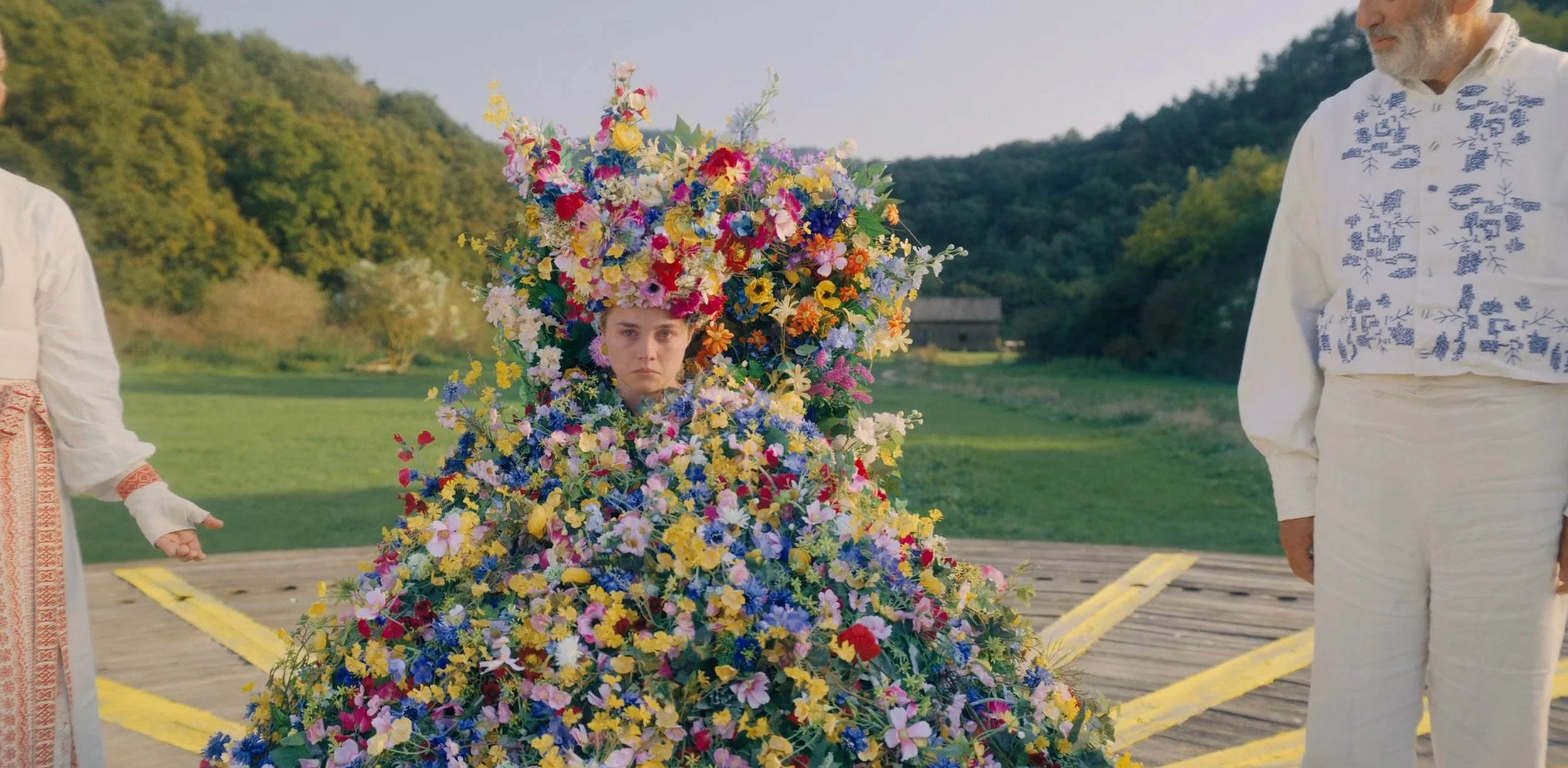Midsommar and Grief
Grief is loudly central to Ari Aster’s 2019 folk horror film Midsommar. Dani (Florence Pugh) speedruns bereavement’s messy stations, and whether by brainwash or self-actualization, she gets her release. A transformation bound to the tiny Swedish village of Hårga, heavy doses of Hårgan rituals and psychedelics allow Dani to uncover space for her feelings. The film is consumed with Dani’s grief, yet it also spends significant time on Hårgan ideas of grief. Each time Dani reaches a cathartic crescendo, she’s surrounded by—for lack of a better descriptor—Hårgan support systems. Her grief becomes entwined with Hårgan expressions of grief. Yet as Dani’s enigmatic smile floats over the film’s final frames, knowing the carnage, the lives lost, what could grief possibly mean to Hårga?
Dani’s journey to Hårga begins with the loss of her family. Tragic deaths, total devastation, Dani seeks comfort from her boyfriend Christian (Jack Reynor) who’s at that magical, “But what if I dump her and regret it?” stage of the relationship. About to sneak off on a six-week long boys’ trip to Sweden, Dani finds out, and Christian begrudgingly invites her. After a long flight, a long car ride, and one of the most accurately rendered mushroom trips in cinema history, Dani awakes for the walk to Hårga.
At the end of a path littered with yellow flowers, the small village is sealed in time, bucolic, and bound to tradition. Hårga’s story of itself is everywhere, stitched in the clothing, painted on the walls in exquisite detail, and woven into a rather instructive ‘love spell’ tapestry. It’s through this deeply developed sense of Hårgan culture that the film gets its first outright mention of grief.
“Each runic letter stands for one of the sixteen affekts which are graded from most holy to most unholy. This one, for example, is about grief,” or so says village father Arne, singling out one rune of many, as he explains Hårga’s sacred text, the Rubi Radr.
Where grief’s assigned grade is not made apparent, it does illustrate deeper Hårgan notions of grief. Grief is foundational to Hårgan life. Grief has a fixed value on their chosen scale of sacred to profane. Holiness or unholiness doesn’t appear to prevent the use of certain affekts, the runes Arne shows are represented throughout Hårga. Each affekt may have a discrete runic letter, but they are sixteen parts of a volatile whole. And above all else, life in Hårga comes with order. This includes grief’s trigger: death.
According to the gang’s instigating Swedish friend Pelle (Vilhelm Blomgren), Hårgan life follows four cycles. “You are a child until you're eighteen, and that is the spring. Then from eighteen to thirty-six, we all do our pilgrimage which is the summer. Then from thirty-six to fifty-four, we work, and that is the fall. Lastly, from fifty-four to seventy-two we become a mentor which is the winter.” At seventy-two, Hårgans give themselves over to ritual death.
Death, and its fairness, are contentious points around Midsommar. Did Dani’s obnoxious boyfriend’s friends deserve to be butchered? Did Christian deserve to be burned alive in a bear pelt for being said shitty boyfriend? Hårga’s answer? Death is the fair part.
“Instead of dying in pain or fear or shame, we give our life as a gesture. There’s no good dying fighting back against the inevitable. It corrupts the spirit.” Said by village mother Siv (Gunnel Fred) while trying to calm outsiders who just witnessed a skull hammer procession, she makes the Hårgan position on death clear. It’s not personal!
Imagine an article on Hårgan Midsommar customs. Say dogged academic Josh (William Jackson Harper) hadn’t died doing what he loved most (homework) and penned his thesis. And then that got digested into an accessible long read which was all like, “In the fiery culmination of a ceremony observed once every 90 years, Hårgans sacrifice an equal number of their own dead to outsiders.” All tidied up as an anthropological fact, it hits a little different. To go full editorial, “Knowing their own lives were on offer by introducing ‘new’ blood for ritual sacrifice, the Hårgan idea of death could be understood as universal, a duty shared equally between all humankind.”
A detached academic eye doesn’t undo the horror of Hårgans’ self-appointed permission for murder. They get to choose, outsiders don’t. Their rituals require death. The murders don’t even feel malicious, which is deeply evil in its own way. Yet, despite Hårgan’s visceral embrace of death, there is still a demand for grief.
While the film’s climactic blaze is lit, an off-screen invocation recalls a central idea. “Mighty and dreadful beast, with you, we purge our most unholy affekts.” When Dani and the Hårgans begin their lamentations, where does this grief fall among the sixteen affekts from most holy to most unholy?
As something most holy, perhaps it’s an expression of sacred, collective grief. Of grieving’s many cruelties, its expected loneliness is the most pernicious. Hårga creates conditions where, without judgment, lost lives can be grieved together, screaming, in a way those wounds demand. Here, Dani ascends to a fairy tale. Wicked bear slain, crown in place, she’s earned her kingdom: a place to weep. But that’s a generous reading.
As the most unholy, grief becomes wickedness to purge. Twice in the film, Hårgans watch gruesome death without reaction until a human suffers. On cue, the group then lurches into terrible moans. This is pain as a formality, a grief exorcism ritual pre-fitted with absolution. Now Dani’s story becomes a tragedy. Adding to the pile of useless death where her family already rots, her hollow elation is merely service to a cruel village and its bloody traditions.
Though, what if among these supposed sixteen Hårgan affekts grief sits at the exact middle? Where the holy and unholy meet in equal measure is a human. What better avatar for that divine paradox than grief? Grief is pain you keep. Grief is made of memories it changes over time. Grief is the constant, irreconcilable act of holding on and letting go. It’s irrational, like so many necessary parts of being a person.
In the film’s screenplay text, this is what’s written about Dani’s final smile, “She has surrendered to a joy known only by the insane. She has lost herself completely, and she is finally free. It is horrible and it is beautiful.” So, if Midsommar articulates anything about grief, it’s the sheer aching contradiction. In grief, you’re the May Queen and the burning bear. Time may grant us equilibrium, but grief will always exist on the knife-edge between bliss and tears. Terrible and beautiful, grief is a kind of madness.
If you enjoyed this article, please consider becoming a patron of Hyperreal Film Journal for as low as $3 a month!




Monte Monreal is an essayist, novelist, and screenwriter based in Austin, TX.